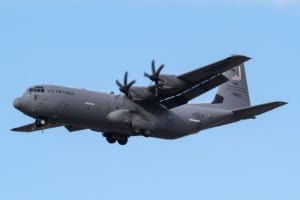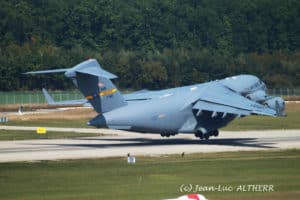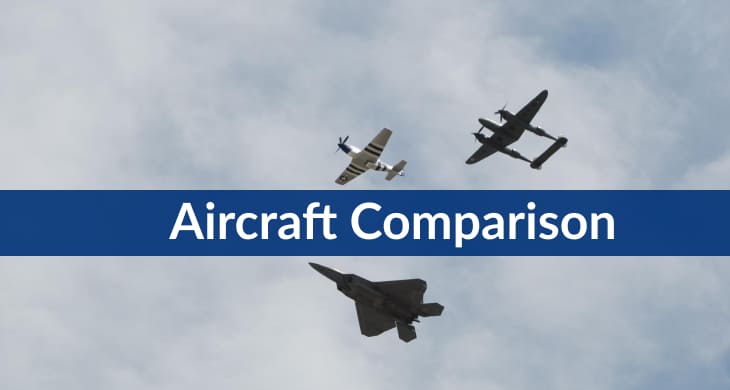Have you ever wondered what the differences are between the C130 vs C17, two of the most iconic planes in military history?
This article will explore the similarities and differences between the two aircraft, so you can better understand why each has been a popular choice for military transport.
| Aircraft: | Lockheed Martin C-130J Super Hercules | Boeing C-17 Globemaster III |
|---|---|---|
| Photo: |
 |
 |
| Country: | United States | United States |
| Manufactured: | from: 1996 to: Present | from: 1991 to: 2015 |
| ICAO: | C130 | C17 |
| Price: | $75.5 million | $218 million |
| Avionics: | Lockheed C-130X AMP Avionics | BAE Systems Avionics , AlliedSignal AN/APS-133(V) weather and mapping radar |
| Engine: | 4x Rolls-Royce AE 2100D3 | 4x Pratt & Whitney F117-PW-100 |
| Engine Type: | Turboprop | Turbofan |
| Power: | 4,700 horsepower | 40,440 pound-force |
| Max Cruise Speed: |
365 knots 676 Km/h |
450 knots 833 Km/h |
| Approach Speed (Vref): | 120 knots | 115 knots |
| Travel Range: |
2,390 Nautical Miles
4,426 Kilometers |
2,420 Nautical Miles
4,482 Kilometers |
| Fuel Economy: |
0.22 nautical mile / gallon 0.108 kilometres / litre |
0.07 nautical mile / gallon 0.034 kilometres / litre |
| Service Ceiling: | 33,000 feet | 45,000 feet |
| Rate of Climb: |
1830 feet / minute 9.30metre / second |
1500 feet / minute 7.62metre / second |
| Take Off Distance: |
1573 metre 5,160.70 feet |
2316 metre 7,598.33 feet |
| Landing Distance: |
792 metre 2,598.39 feet |
914 metre 2,998.65 feet |
| Max Take Off Weight: |
79,365 Kg 174,968 lbs |
265,352 Kg 584,995 lbs |
| Max Landing Weight: |
58,957 Kg 129,977 lbs |
202,721 Kg 446,919 lbs |
| Max Payload: |
21,500 Kg 47,399 lbs |
77,520 Kg 170,901 lbs |
| Fuel Tank Capacity: |
9,680 gallon 36,643 litre |
35,546 gallon 134,556 litre |
| Baggage Volume: |
170 m3 6,003 ft3 |
591.8 m3 20,899 ft3 |
| Seats - Economy: | 92 seats | 102 seats |
| Seats - Business Class: | - | - |
| Seats - First Class: | - | - |
| Cabin Height: |
2.74 metre 8.99 feet |
4.5 metre 14.76 feet |
| Cabin Width: |
3.12 metre 10.24 feet |
5.49 metre 18.01 feet |
| Cabin Length: |
16.9 metre 55.45 feet |
26.82 metre 87.99 feet |
| Exterior Length: |
34.37 metre 112.76 feet |
53 metre 173.88 feet |
| Tail Height: | 11.84 metre - 38.84 feet | 16.79 metre - 55.08 feet |
| Fuselage Diameter: |
4.32 metre 14.17 feet |
6.86 metre 22.51 feet |
| Wing Span / Rotor Diameter: |
40.4 metre 132.54 feet |
51.75 metre 169.78 feet |
| Wing Tips: | No Winglets | Canted Winglets |
| More Info: | Lockheed Martin C-130J Super Hercules | Boeing C-17 Globemaster III |
|
Data presented is for entertainment purposes and should not be used operationally.
|
Other Lockheed Martin C-130J Super Hercules comparisons:
Other Boeing C-17 Globemaster III comparisons:
About the Lockheed C-130 Hercules
Let’s start by exploring the Lockheed C-130 Hercules. It has been in service since the 1950s and is one of the world’s most widely used military transport aircraft. Also, its versatile design makes it ideal for various purposes.
Why was it developed and built?
The Lockheed C-130 Hercules was designed for tactical airlift support, transporting personnel and supplies over short distances. Its versatile design allows for troop and cargo transport and aerial refueling.
What purpose does it serve?
Starting as a tactical transport aircraft, the Lockheed C-130 Hercules is capable of short takeoffs and landings on rough terrain, making it ideal for transporting troops and supplies over short distances. With time, the Lockheed C-130 Hercules has been modified for various roles, such as medical evacuation, aerial refueling, search and rescue, and special operations.
About the Boeing C-17 Globemaster III
The C-17 Globemaster III is the newest and largest military airlift aircraft in service. Developed by Boeing, it has been in service since the mid-1990s.
Why was it developed and built?
The C-17 Globemaster III was built to fulfill the US Air Force’s need for a large cargo transport aircraft that could operate from austere runways and other harsh environments. It was also built to replace the aging fleet of C-141s, which had been in service since the 1960s.
What purpose does it serve?
Mostly used for strategic airlift missions, the C-17 Globemaster III can transport large payloads over long distances. It can also be used for humanitarian aid, medical evacuation, and other special operations.
How are the Lockheed C-130 Hercules and Boeing C-17 Globemaster III different?
The Lockheed C-130 Hercules and Boeing C-17 Globemaster III have been used by militaries worldwide for decades, but how do they compare? Let’s look at five key differences between these two remarkable aircraft.
Size
Size is the first difference between these two aircraft. The Lockheed C-130 Hercules has a wingspan of 132 feet, while the C-17 Globemaster III has a wingspan of 169 feet. This means the Boeing C-17 Globemaster III is larger than the Lockheed C-130 Hercules by almost 40 feet!
Range
Regarding range, there is also a significant difference between these two aircraft. The Lockheed C-130 Hercules has a maximum range of 2,360 miles, while the Boeing C-17 Globemaster III has a maximum range of 2,780 miles! This increased range allows militaries worldwide to conduct long-range missions easily.
Speed
Both aircraft are capable of speed, but there is still a noticeable difference between them in terms of performance capabilities. The Lockheed C-130 Hercules can reach up to 370 mph, while the Boeing C-17 Globemaster III can reach speeds up to 520 mph – making it one of the fastest military aircraft!
Engines
Nest in line is the number of engines they use for power. The Lockheed C-130 Hercules is powered by four turboprop engines, while the Boeing C-17 Globemaster III has three jet engines. This makes it more powerful and efficient than its predecessor!
How are the Lockheed C-130 Hercules and Boeing C-17 Globemaster III Similar?
The Lockheed C-130 Hercules and the Boeing C-17 Globemaster III, two of the most well-known aircraft in the world, have a few notable similarities.
- Both are four-engine turboprop military transport aircraft with exceptional capacities for short takeoff and landing on various terrains.
- They also feature versatile cargo configurations that enable them to perform tactical airlift missions to transport troops and freight.
- Furthermore, these multirole aircraft can provide humanitarian aid and deploy parachute drops – a key capability many other cargo planes do not have.
In essence, this remarkable pair of planes combine cargo loading options with disaster relief capabilities and incredible performance power, making them modern marvels of mobility.
What’s better about the Lockheed C-130 Hercules?
The Lockheed C-130 Hercules has earned its place as an aviation workhorse, beloved worldwide for its extraordinary durability and reliability. This powerful aircraft has many advantages to offer.
- The Hercules boasts four engines delivering a maximum power of 3,420 kW – enough to lift off much more quickly than comparable planes.
- Additionally, it ensures more straightforward airlifting operations due to its built-in loading ramp and opening rear hatch so that cargo can be loaded or unloaded in almost any terrain.
- Its payload capacity is hefty, too — at around 42,000 kb, it can carry up to nine tons of cargo over a range of up to 4000 miles without refueling.
It’s no wonder they are used in missions by militaries and governments across the globe!
What’s better about the Boeing C-17 Globemaster III?
The Boeing C-17 Globemaster III has an impressive range and crew capability that put other cargo planes to shame.
- This large aircraft can haul up to 170,900 lb of cargo, fly for over 4,500 miles nonstop, and is capable of landing on short runways.
- In addition to its amazing range, it is designed with long-term durability to outlast other cargo planes in tough environments with minimal maintenance and servicing.
- Its most outstanding feature is its ability to take off and land on unprepared airfields, including sand, dirt, and snow-covered areas.
- It also has advanced real-time battlefield simulations for flight maneuvering training exercises.
With its superior controls, auto flight systems, wing shape design, and powerful engines, the Boeing C-17 Globemaster III truly sets itself apart from other cargo planes.
Conclusion
Both planes have been instrumental in serving militaries around the world for years. As we have seen, there are some clear differences between them. It gives each one advantage and disadvantages compared to one another depending on their purpose or mission requirements.


